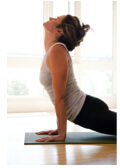Non-Drug Approaches for Low Back Pain

Revised Physician Guidelines Shift to Non-Drug Approaches as First Line Treatment for Low Back Pain
 In a revision of clinical guidelines, the American College of Physicians is recommending non-drug approaches as a first line treatment for acute, sub-acute and chronic low back pain. These changes are based in part on new evidence showing that two majors drugs used for pain relief were no better than placebos. In other words, they were of no benefit in treating low back pain. Guidelines also recommend that physicians advise patients that most pain is likely to diminish with consistent exercise, good nutrition and physical activity. This is a huge shift from the previous position of the American College of Physicians which used to call for the use of medication as a first line treatment. These guidelines were released on Feb 13, 2017.
In a revision of clinical guidelines, the American College of Physicians is recommending non-drug approaches as a first line treatment for acute, sub-acute and chronic low back pain. These changes are based in part on new evidence showing that two majors drugs used for pain relief were no better than placebos. In other words, they were of no benefit in treating low back pain. Guidelines also recommend that physicians advise patients that most pain is likely to diminish with consistent exercise, good nutrition and physical activity. This is a huge shift from the previous position of the American College of Physicians which used to call for the use of medication as a first line treatment. These guidelines were released on Feb 13, 2017.
Researchers analyzed studies on the effectiveness of both pharmacologic (drugs) and non-drug treatments for all types of low back pain. The drug based treatments studied, ran the gamut from acetaminophen to opioids – including antidepressant medications. Non-drug treatments included spinal manipulation, rehabilitation, massage, exercise and related therapies and various physical modalities.
 In the end, researchers reestablished the effectiveness of exercise and maintaining daily activities but also saw a weakening in the evidence supporting the use of medications. In the chronic levels (pain lasting more than 12 weeks) the guidelines strongly recommend exercise, multidisciplinary rehabilitation, acupuncture, mindfulness-based stress reduction, Tai Chi, Yoga, motor control exercises and other non-drug approaches.
In the end, researchers reestablished the effectiveness of exercise and maintaining daily activities but also saw a weakening in the evidence supporting the use of medications. In the chronic levels (pain lasting more than 12 weeks) the guidelines strongly recommend exercise, multidisciplinary rehabilitation, acupuncture, mindfulness-based stress reduction, Tai Chi, Yoga, motor control exercises and other non-drug approaches.
This supports what I have already known: Most low back pain will improve with the proper exercise regime. As a Physical Therapist, I look at the movement patterns of the patient and where the muscles are strong/weak and/or tight to address the changes in movement that occurs after injuries (minor and major). These changes in movement will allow the back to get over-stressed, contributing to pain and disc degeneration. Giving meds simply covers up the problem – it does not fix it. You need to correct the movement pattern to fix the problem.
Remember, we always offer a free pain screening and our therapists can look at your movement patterns and see what we can do to help eliminate your pain. Please contact us today at (414) 425-9700 for your free screening.
